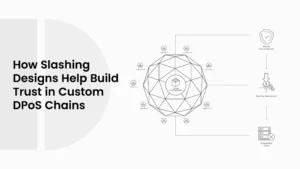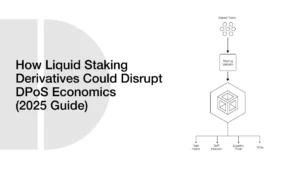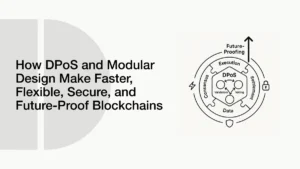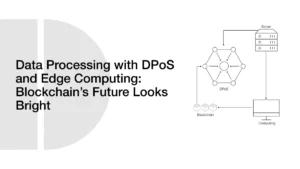Russia, Switzerland Tried It, Will Others Follow Suit? | DPoS For Fair, Secure, and Reliable Elections
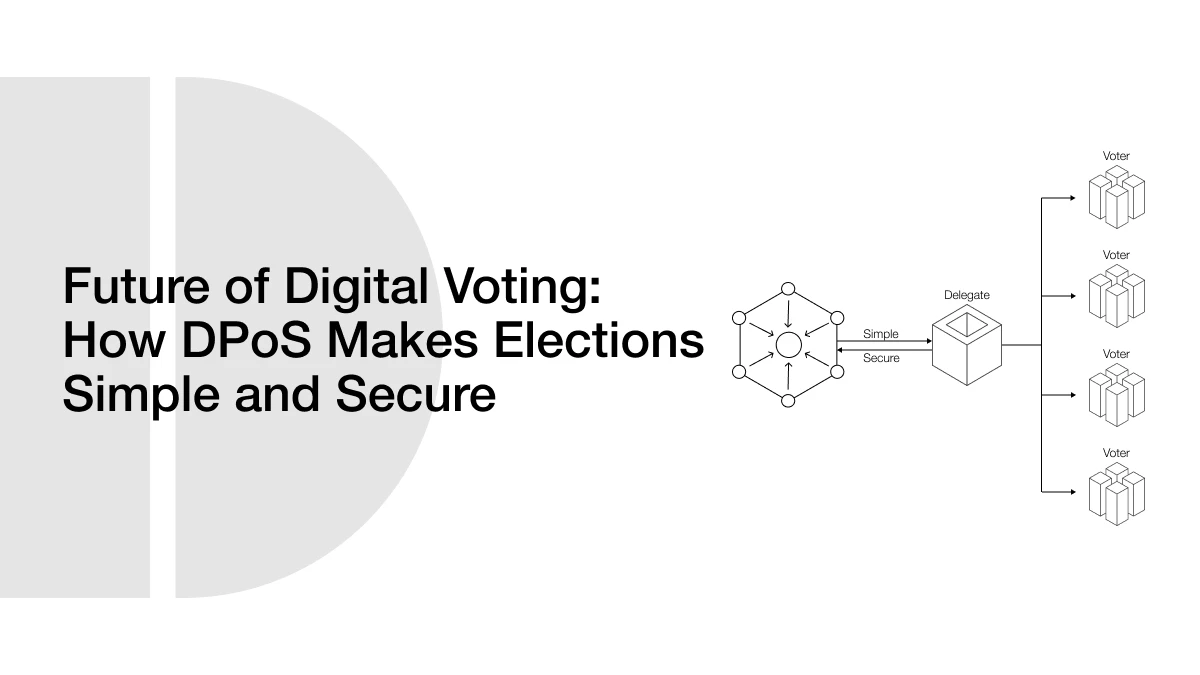
Voting is one of the most important parts of democracy. For many years, people have used paper ballots to make their voices heard. Later, electronic machines were added to speed up the process. Today, with the rise of digital technology, people are looking at something even bigger: voting on the blockchain.
- What is Delegated Proof of Stake (DPoS)?
- Comparing PoW, PoS, and DPoS for Voting
- Why Voting UX Matters in Digital Democracy
- Evolution of E-Voting Systems: From Paper to Blockchain
- Traditional Voting vs Blockchain Voting
- How DPoS Improves Voting Systems
- Transparency and Trust with Blockchain
- Reducing Barriers for Voters
- Security Features of DPoS Voting
- UX Challenges in Blockchain Voting
- Making DPoS User-Friendly for Mass Adoption
- Simplified Voter Interfaces
- Easy Authentication
- Education and Transparency
- UX Barriers and DPoS Solutions
- Global Case Studies of Blockchain Voting UX
- Estonia: Leading the Way in Internet Voting
- Switzerland: Testing Blockchain Pilots
- Moscow: Active Citizen Program
- West Virginia, USA: Voatz App
- Country Case Studies and UX Lessons Learned
- Future of Voting UX in DPoS Systems
- Challenges Ahead for Mass Adoption
- Conclusion
- Frequently Asked Questions About the Future of Digital Voting with DPoS
- What is Delegated Proof of Stake (DPoS)?
- How does DPoS improve voting?
- Can people vote using their smartphones in DPoS systems?
- What challenges stop DPoS voting from mass adoption?
- Is DPoS voting secure?
- Glossary of Key Terms
Delegated Proof of Stake (DPoS) is one of the most popular blockchain systems under consideration to be used in voting. This system is characterized as more energy-efficient and faster than the previous blockchain models, such as Proof of Work. Many specialists believe DPoS can be used to ensure secure elections, which are transparent and fair to all. However, it has a big challenge, that is, user experience (UX).
If voting systems are complicated, there is a possibility that they will not be trusted by people, or they will not want to use them. A voting system has to be simple, secure, and understandable by all voters regardless of their level of technological knowledge. Voting UX is important because of this. An easy and sleek design will make millions of people use digital voting without worry or misunderstanding.
Countries like Estonia and Switzerland have already tested blockchain-based voting systems. Their experiments show that blockchain can bring more transparency and trust to elections (Trechsel & Vassil, 2010). However, these systems also highlight the need to focus on how voters interact with the technology. It is not only about security, but it is also about making sure the process feels natural and friendly.
This blog will explore how DPoS voting can evolve with better UX. Plus, this blog will look at how voting has changed over time, why UX is so important, and how design improvements can make blockchain-based voting ready for mass adoption. In the end, the goal is simple: to make sure every voter feels safe, comfortable, and confident when casting their vote in the digital age.
ALSO READ: How DPoS Offers Secure and Scalable Governance in the Future of Smart Cities
What is Delegated Proof of Stake (DPoS)?
Delegated Proof of Stake (DPoS) is a particular blockchain system. It is commonly applied in situations where individuals need quick and safe transactions, e.g., online voting. To get a grasp of DPoS, it is useful to contrast it with two other popular blockchain systems, Proof of Work (PoW) and Proof of Stake (PoS).
In Proof of Work, computers must solve extremely complex mathematical problems to confirm transactions. This takes a lot of time and energy. It works for systems like Bitcoin, but it is too slow for voting. In Proof of Stake, people “stake” or lock up their coins to get the right to confirm transactions. This system uses less energy than PoW, but it can still be slow and costly if many people are involved.
DPoS is different. Instead of everyone trying to confirm transactions, people vote for a small group of representatives called delegates. These delegates are responsible for adding new transactions or, in the case of voting, recording the votes. If a delegate does not do their job well, voters can quickly replace them with someone else. This keeps the system fast, secure, and accountable.
The primary rationale why DPoS is exciting to vote for is that it is grounded in trust and speed. Votes could be counted much faster than waiting hours or even days to get results. In addition, since the system is transparent, anyone can verify the records to ensure that votes are not altered.
Comparing PoW, PoS, and DPoS for Voting
| Feature | Proof of Work (PoW) | Proof of Stake (PoS) | Delegated Proof of Stake (DPoS) |
| Energy Use | Very high (uses lots of electricity) | Medium (less energy than PoW) | Very low (energy efficient) |
| Speed | Slow (minutes or hours per block) | Faster than PoW but still limited | Very fast (seconds per block) |
| Voter Role | Not used for voting directly | Stakeholders confirm transactions | Voters choose delegates to confirm votes |
| Best For | Bitcoin, high security but slow systems | General transactions, moderate use | Voting, elections, and systems needing speed and scale |
As seen in the table, DPoS is the best fit for digital voting. It is fast, fair, and energy-friendly. Most importantly, it gives people the power to hold delegates accountable, which keeps the system honest.
Why Voting UX Matters in Digital Democracy
When people hear the word “voting,” they often think about fairness, trust, and freedom. But in the digital age, there is another important factor: user experience (UX). User experience is merely how easy, smooth, and clear it is for someone to use a system. When the voting system is overly complex or difficult to use, people will have no confidence in it. They may even abstain from voting.
In typical elections, the procedure is known. Individuals enter a polling facility, present their identification, and write on a sheet of paper. It is common knowledge, and it is safe since they observe it right in front of their eyes. By contrast, when voting becomes online or on a blockchain, the process takes a very different appearance. People are replaced by digital screens, encryption, and occasionally, technical terms that they do not comprehend. This brings uncertainty and fear. When a system is perceived to be complex, even if it is safe, most individuals will fear using it.
Good UX helps solve this problem. An easy, understandable, and welcoming design may make citizens feel secure and comfortable during the voting process. As an example, internet voting has been in use in Estonia for years. One of the primary reasons why it works is that researchers discovered that the platform is easy and simple to use. Voters will tend to vote when they are comfortable.
ALSO READ: DPoS in 6G Networks: The Future of Blockchain and Hyperconnected Economies
Voting UX also involves a lot of accessibility. Individuals who have disabilities or those who live too far to access polling stations have difficulties in voting in most countries. That can be changed by a convenient digital voting system. When properly designed, it will allow individuals to vote at home or on a mobile phone, or even in other languages. This increases the inclusiveness of democracy and makes it open to all.
Transparency is another key part of UX. Voters want to know that their vote is counted correctly. In blockchain systems, this can be shown by giving voters a receipt or a way to check their vote on the blockchain without revealing their identity. If people can easily verify that their vote is secure, trust in the system grows (Noizat, 2015).
In short, UX in digital voting is not just about design. It is about trust, access, and confidence. A smooth user experience makes people feel included and respected. And when voters trust the system, democracy becomes stronger.
Evolution of E-Voting Systems: From Paper to Blockchain
There has been a lot of change in voting. Initially, individuals were using paper ballots. This was an easy way; however, it was full of issues. Votes were lost, altered, or miscounted. Paper votes were also time-consuming to count, particularly in the larger countries where millions of people voted.
In the future, the introduction of electronic voting machines would follow. These machines were quicker to count, and they minimized certain errors. Nevertheless, they were not without problems. There was a risk of machine failure or hacking. There was also a fear that the results may be manipulated without detection by some people.
In recent years, countries have started testing online voting. This made things easier for people who could not travel to polling stations. For example, Estonia was the first country to hold nationwide internet voting. Switzerland has also tested digital voting in some regions. These projects showed that online voting can save time and make voting more accessible (Serdült et al., 2015). But they also showed that people will only trust the system if it feels safe and user-friendly.
That is where blockchain comes in. Blockchain is a technology that encrypts information in a safe and immutable manner. When anything is written on the blockchain, it cannot be changed. This is quite convenient in voting. Transparency and verifiability. In blockchain, each vote is documented in a transparent and verifiable manner. Meanwhile, the voters are anonymous. It is this privacy and transparency that is the reason many professionals think blockchain is the future of e-voting.
Traditional Voting vs Blockchain Voting
| Feature | Traditional Paper Voting | Electronic/Online Voting | Blockchain Voting |
| Speed of Counting | Slow (manual counting) | Faster than paper | Very fast (real-time tallying) |
| Security | Can be tampered with or lost | Can be hacked or corrupted | Highly secure, tamper-proof |
| Transparency | Limited (depends on trust in officials) | Some audit features | Full transparency with verifiable records |
| Accessibility | Requires in-person presence | Remote access possible | Remote, global, and inclusive |
| Voter Trust | High due to familiarity | Mixed, depends on design | Can be high if UX is simple and clear |
This table shows that blockchain offers a mix of speed, security, and transparency that older systems cannot fully provide. But again, the success of blockchain voting depends on UX design. If voters cannot understand or trust the interface, they will not use it, even if the technology behind it is perfect.
How DPoS Improves Voting Systems
Delegated Proof of Stake (DPoS) is not only fast but also well-suited for modern voting systems. It solves many of the problems that older voting technologies face. By allowing voters to choose delegates who manage the system, DPoS creates a model that is both efficient and accountable.
Transparency and Trust with Blockchain
In DPoS voting, every action is recorded on the blockchain. This means votes cannot be secretly changed or deleted. Voters can verify that their vote was counted anonymously. Such openness generates trust. The system acts as the authority on matters of truth instead of relying on a central authority.
Electronic voting research on blockchain-based electoral processes, e.g., internet voting in Estonia, demonstrates that transparency is among the largest determinants of whether humans trust e-voting. Voters will feel confident when they get evidence that their decisions are safe.
ALSO READ: How Edge AI Optimizes Delegate Performance in Real-Time for Faster DPoS Blockchain
Reducing Barriers for Voters
Traditional elections often come with barriers. People need to travel to polling stations, wait in lines, or deal with limited voting hours. On DPoS-based systems, voting can be accomplished online within seconds. This favors the disabled, individuals who are abroad, or any other individual with reduced mobility.
DPoS-based apps and sites can also be user-friendly and multi-language, or accessible. This reduces the digital divide and helps ensure that more people can take part in elections. The result is higher voter turnout and a more inclusive democracy.
Security Features of DPoS Voting
DPoS is secure. Votes can only be recorded by the elected delegates, and they can be swapped easily if they are dishonest. The blockchain is decentralized; hence, there is no point of failure. This is such that hackers find it extremely difficult to attack the system.
DPoS is also compatible with more complicated cryptographic mechanisms such as zero-knowledge proofs and digital signatures. Such tools make the votes secret and impossible to use to identify the voter. Simultaneously, they enable the people to ensure that the vote count is accurate.
Together, these features make DPoS one of the best models for building safe, scalable, and trusted voting systems.
UX Challenges in Blockchain Voting
Even though DPoS and blockchain bring many benefits, there are still big challenges when it comes to user experience. A system may be secure and transparent, but if people find it hard to use, they will not trust it. One of the first problems is technical language. In blockchain systems, one can find such words as keys, hashes, and nodes. To the non-tech-savvy, these words are confusing. When the voters lack the necessary knowledge about what they are watching on the screen, they can become confused or distrust the process entirely.
The other difficulty is the wallets and the keys. Many blockchain systems require a user to have a digital wallet and protect the private keys. This is stressful to ordinary voters. If someone loses their private key, they may lose access to their vote. This is entirely unlike the paper ballots, where the process is not technical and is easy to go through. There is also the issue of fear of fraud and hacking. Even if a blockchain is secure, people may still worry that hackers can break in. Media stories about cyberattacks make people cautious. If the voting system does not explain clearly how security works, many people will hesitate to use it.
Finally, the digital divide makes adoption harder. Not all people have access to high-speed internet, a mobile phone, and digital literacy. The elderly, rural dwellers, and individuals with disabilities might not cope with complicated platforms. When these groups cannot easily use the system, then they will be effectively excluded from democracy. These UX issues demonstrate that it is not enough to create secure technology. The other half is making sure the system feels simple, safe, and friendly to the voter. Without this, even the best blockchain-based voting system will struggle to gain mass adoption.
Making DPoS User-Friendly for Mass Adoption
For DPoS to reach mass adoption, the system must feel as simple as using an ATM or a mobile app. People should not need deep technical knowledge to vote securely. By focusing on design, authentication, and education, DPoS voting can become a trusted tool for digital democracy.
Simplified Voter Interfaces
The first step is making the voting interface easy to use. Instead of technical screens full of blockchain terms, voters should see clear buttons, simple instructions, and visual confirmations. For example, a mobile app could show the ballot in plain language, allow one-tap voting, and then give a receipt that says, “Your vote has been recorded.”
Estonia’s internet voting success proves this point. The system works not just because it is secure, but because it feels easy and natural to use. A simple design lowers stress and increases trust.
Easy Authentication
Many voters are used to logging in with a fingerprint, a face scan, or a government-issued ID. Blockchain voting can use these same tools for authentication. Instead of handling private keys themselves, voters could log in with secure biometric methods or digital ID cards. This balances convenience and security.
Switzerland’s blockchain voting pilots also showed that clear and smooth authentication helps increase trust. If people feel the login process is familiar and quick, they are more likely to use the system (Serdült et al., 2015).
Education and Transparency
A user-friendly system must also educate its users. Many people are nervous about new technology. Simple tutorials, demo votes, and clear explanations can make voters feel comfortable. For example, giving every voter a chance to try a practice ballot before election day can build confidence.
Transparency also helps. If voters can see a receipt or check that their vote is included on the blockchain (without revealing who they voted for), they will feel reassured. This kind of visible proof turns a complex blockchain system into something ordinary citizens can trust.
UX Barriers and DPoS Solutions
| UX Barrier | Problem for Voters | DPoS-Based Solution |
| Complex technical terms | Confuses non-technical voters | Use plain language and icons |
| Private key management | Risk of losing access to vote | Secure biometric login or digital ID |
| Fear of fraud or hacking | Low trust in digital platforms | Provide receipts and public audit trails |
| Digital divide | Excludes older adults and rural communities | Build mobile-friendly and accessible apps |
By focusing on these solutions, DPoS can become much more than just a secure technology. It can become a friendly voting experience that ordinary citizens will adopt with confidence.
Global Case Studies of Blockchain Voting UX
Around the world, governments and organizations are already testing blockchain-based voting. These case studies show both the progress and the challenges of making e-voting simple, secure, and trusted.
Estonia: Leading the Way in Internet Voting
Estonia is the first country in the world to offer internet voting nationwide. Citizens can vote online using their national ID cards. The system is secure and has been used for more than a decade. One reason it works is that the design is simple. Voters log in with their ID card, select their candidate, and confirm. The whole process feels natural, almost like online banking. Still, Estonia continues to improve transparency so voters feel fully confident in the system.
Switzerland: Testing Blockchain Pilots
Switzerland has carried out several pilots with blockchain voting. The goal was to improve security and give voters a way to verify their vote on the blockchain. The pilots showed that people liked the idea of checking their vote, but some found the process too technical. This highlighted the need for simple user guides and clear instructions.
Moscow: Active Citizen Program
Moscow created the “Active Citizen” program to let residents vote on local issues using blockchain. The system was transparent and showed real-time results. However, many users complained about trust. They felt the interface was not clear enough, and some worried the government could still manipulate votes. This showed that even with blockchain, UX and trust go hand in hand.
West Virginia, USA: Voatz App
In 2018, West Virginia tested the Voatz app, which used blockchain and biometric security for military voters overseas. Voters liked the convenience, but experts found security risks in the app’s design. The lesson here is that while mobile apps make voting easy, they must be built with both strong security and user-friendly features.
Country Case Studies and UX Lessons Learned
| Country | Type of Voting | UX Strength | UX Weakness | Lesson Learned |
| Estonia | Nationwide internet voting | Simple and familiar process | Needs ongoing transparency | Easy design builds trust |
| Switzerland | Blockchain voting pilots | Voter verification on blockchain | Instructions were too technical | Clear guides improve adoption |
| Moscow | Active Citizen platform | Real-time transparency | Weak trust in interface | UX and trust must work together |
| West Virginia (USA) | Voatz mobile app for overseas voters | Easy mobile access | Security flaws in design | Security and UX must balance |
Future of Voting UX in DPoS Systems
Voting is at the heart of Delegated Proof of Stake (DPoS). Token holders use their votes to choose delegates who run the blockchain. But the way users vote is not always simple. Many DPoS networks still have voting dashboards that look too technical, with charts, numbers, and confusing menus. This makes it harder for everyday people to join the process.
In the future, the voting experience (UX) in DPoS systems will resemble using a simple mobile app. Instead of scrolling through long lists of delegates, users may see clean profiles with photos, ratings, and performance history. Voting could feel like “liking” a creator on a social media app, or clicking a button that says “support this delegate.” By making it easier and faster, more people will take part in the decision-making.
Another big step will be real-time transparency. Right now, many voters cast their votes but do not see what happens afterward. With better UX design, voters could get live updates on how their chosen delegate is performing. For example, a notification might say: “Your delegate just validated 10 new blocks without errors this week.” This feedback loop builds trust and makes voters feel that their choice really matters.
Gamification may also shape the future of voting UX. Delegates could earn badges for strong performance, while voters might unlock rewards for being active participants. This not only improves engagement but also creates a sense of community inside the blockchain. The goal is to make governance less like a complex financial system and more like an inclusive, interactive platform.
By improving UX, DPoS systems will become more democratic, transparent, and user-friendly. This could help reduce voter apathy, increase fairness, and create a governance model that feels natural for both experts and beginners.
Challenges Ahead for Mass Adoption
Even though DPoS looks like a sound system for faster and fairer voting, there are still many challenges before it can be used everywhere. Mass adoption means that millions of people, across many countries, will use the system daily. That is not easy to achieve.
One challenge is technology access. Not everyone has strong internet or smartphones that can handle secure voting apps. In developing countries, this gap can make it harder for people to join digital voting. If the system is not equally open to all, it risks leaving some people behind.
Another issue is trust in technology. Many people are still not comfortable using blockchain or digital wallets. They may not fully understand how DPoS works, and fear of mistakes or fraud can stop them from trying. Governments also need strong rules and clear audits to prove that the votes are safe and cannot be changed.
Scalability is also a big challenge. Voting is not like regular blockchain transactions. It can involve millions of people casting votes at the same time. If the system is not ready to handle such heavy traffic, it could slow down or even crash. That would make people lose faith in digital voting.
Finally, there is the problem of global standards. Each country has its own election rules, laws, and ways of protecting voter privacy. For DPoS-based voting to spread worldwide, developers and policymakers will need to agree on some common rules. Without this, adoption will remain limited to pilot projects and small communities.
Conclusion
Delegated Proof of Stake (DPoS) has the power to change how people vote in the digital age. Making elections faster, safer, and more open can give citizens more trust in the process. The future of voting UX in DPoS systems could look simple, mobile-friendly, and fair for everyone.
But adoption will not be easy. Problems like lack of access to technology, trust issues, scalability, and the need for global rules must be solved. With the right design, clear education, and strong cooperation between governments and developers, DPoS could become the backbone of digital democracy.
The journey is just beginning, but one thing is clear: voting in the future may not involve paper and long lines. Instead, it could happen with a few taps on a phone, powered by blockchain and secured by DPoS.
Frequently Asked Questions About the Future of Digital Voting with DPoS
What is Delegated Proof of Stake (DPoS)?
A: DPoS is a blockchain system where token holders elect delegates who validate transactions and secure the network.
How does DPoS improve voting?
A: It offers faster results, stronger security, and more transparency compared to traditional systems.
Can people vote using their smartphones in DPoS systems?
A: Yes. Mobile-friendly DPoS voting apps can allow citizens to cast their votes from anywhere securely.
What challenges stop DPoS voting from mass adoption?
A: Key challenges include limited tech access, trust issues, scalability, and lack of global legal frameworks.
Is DPoS voting secure?
A: Yes. Because it runs on blockchain, votes cannot be easily changed or hacked, making the process more reliable.
Glossary of Key Terms
- Blockchain: A digital ledger that records data securely across many computers.
- Consensus: The method blockchains use to agree on valid transactions.
- DPoS (Delegated Proof of Stake): A system where users elect delegates to run the network and validate transactions.
- Delegate: A trusted participant chosen to secure the blockchain in DPoS.
- Voting UX: The way people interact with voting systems, including ease of use and trust in the process.

